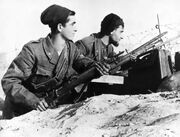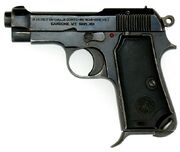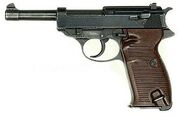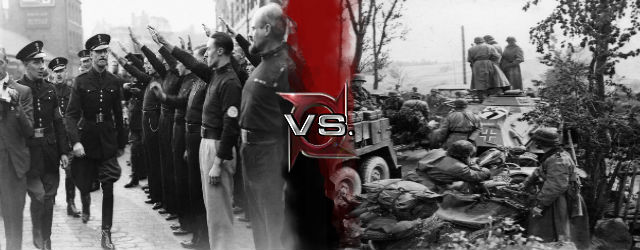We've hit the second half of the of my season and we've moved past the actual commanders, and into actual units themselves.And today we're using two units from two of the most despicable regimes to ever exist. Two units that existed to bully and exterminate the opponents of their leaders.The Milizia Volontaria per la Sicurezza Nazionale or Blackshirts, Mussolini's personal volunteer paramilitary force, who brutally dealt with Il Duce's dissidents. And the 3rd SS Panzer Division "Totenkopf" the combat division based off the SS- Totenkopfverbände who fought brutally from the Battle of France throught the Eastern Front, committing many war crimes.
WHO IS DEADLIEST!
Blackshirts[]

The Italian Blackshirts were the fascist paramilitary forces that helped facilitate Benito Mussolini's rise to power in the early 1920s. His October 1922 March on Rome, an event with heavy Blackshirt involvement, was a bullying tactic that effectively secured fascist control in the Kingdom of Italy. In the interwar years they fought in Ethiopia and served as military police forces. During the Second World War the Blackshirts served in North Africa and in Operation Barbarossa, although in this venture they suffered unsustainable losses. This, coupled with the Allied invasion in 1943, led to the dissolvement of the organization in December of that year.

Carcano is the frequently used name for a series of Italian bolt-action, magazine-fed, repeating military rifles and carbines. Introduced in 1891, this rifle was chambered for the rimless 6.5×52mm Carcano cartridge (Cartuccia Modello 1895). It was developed by the chief technician Salvatore Carcano at the Turin Army Arsenal in 1890 and called the Modello (model) 91 or simply M91. Successively replacing the previous Vetterli-Vitali rifles and carbines in 10.35×47mmR, it was produced from 1892 to 1945. The M91 was used in both rifle and shorter-barreled carbine form by most Italian troops during the First World War and by Italian and some German forces during the Second World War. The rifle was also used during the Winter War by Finland, and again by regular and irregular forces in Syria, Libya, Tunisia, and Algeria during various postwar conflicts in those countries.
Weight:8.6 lbs.
Caliber:6.5x52mm Carcano
Capacity:6-round integral magazine (loaded with an en-bloc clip)
Range:1,000 m effective firing range

The MAB 38 (Moschetto Automatico Beretta Modello 1938), Modello 38, or Model 38 and its variants were a series of official submachine guns of the Royal Italian Army introduced in 1938 and used during World War II. The guns were also used by the German, Romanian, and Argentine armies of the time.
Weight:9.25 lbs.
Rate of Fire:600 rds/min
Caliber:9x19mm Parabellum
Capacity:30-round drum magazine
Range:250 m effective firing range

The Fucile Mitragliatore Breda modello 30 was the standard light machine gun of the Royal Italian Army during World War II.The Breda 30 was rather unusual for a light machine gun. It was fed from a fixed magazine attached to the right side of the weapon and was loaded using brass or steel stripper clips.
Weight:10.6 lbs.
Rate of Fire:150 rds/min (practical rate of fire, technically can go up to 500 rds/min)
Caliber:6.5x52mm Carcano
Capacity:20-round stripper-clips
Range:1,000 m effective firing range

The Beretta Model 1934 is a compact, semi-automatic pistol which was issued as a standard service firearm to the Italian armed forces beginning in 1934. It is chambered for the 9 mm Corto, more commonly known as the .380 ACP.
Weight:1.45 lbs. loaded
Caliber:380 ACP
Capacity:7-round detachable box magazine
Muzzle Velocity:229 m/s3rd SS Panzer Division "Totenkopf[]
The 3rd SS Panzer Division "Totenkopf" (German: 3. SS-Panzerdivision "Totenkopf") was one of 38 divisions of the Waffen-SS of Nazi Germany during World War II. Its name, Totenkopf, is German for "death's head", and it is thus sometimes referred to as the Death's Head Division. Prior to achieving division status, the formation was known as Kampfgruppe (battlegroup) "Eicke". Most of the division's initial personnel belonged to the SS-Totenkopfverbände, and others were members of German militias that had committed war crimes in Poland.
The SS Division Totenkopf was formed in October 1939. The Totenkopf Division had close ties to the camp service and its members. When first formed a total of 6,500 men from the SS-Totenkopfverbände were transferred into the Totenkopf Division. The Totenkopf was initially formed from concentration camp guards of the 1st,2nd, and 3rd regiments of the SS-Totenkopfverbände, and men from the SS Heimwehr Danzig. Members of other SS militias were also transferred into the division in early 1940; these units had been involved in multiple massacres of Polish civilians, political leaders and prisoners of war. The division had officers from the SS-Verfügungstruppe (SS-VT), of whom many had already seen action in Poland.

The Karabiner 98 kurz often abbreviated Kar98k or K98k and often incorrectly referred to as a “K98” (which was a Polish Carbine) is a bolt-action rifle chambered for the 7.92×57mm Mauser cartridge that was adopted on 21 June 1935 as the standard service rifle by the German Wehrmacht. It was one of the final developments in the long line of Mauser military rifles. Although supplemented by semi- and fully automatic rifles during World War II, it remained the primary German service rifle until the end of the war in 1945. Millions were captured by the Soviets at the conclusion of World War II and were widely distributed as military aid. The Karabiner 98k therefore continues to appear in conflicts across the world as they are taken out of storage during times of strife.
Weight:8.2 lb
Caliber: 7.92×57mm Mauser
Capacity:5-round stripper clip, internal magazine
Range:550 yd

The MP 40 (Maschinenpistole 40) is a submachine gun chambered for the 9×19mm Parabellum cartridge. It was developed in Nazi Germany and used extensively by the Axis powers during World War II.
Designed in 1938 by Heinrich Vollmer with inspiration from its predecessor the MP 38, it was heavily used by infantrymen (particularly platoon and squad leaders), and by paratroopers, on the Eastern and Western Fronts. Its advanced and modern features made it a favorite among soldiers and popular in countries from various parts of the world after the war. It was often erroneously called "Schmeisser" by the Allies, although Hugo Schmeisser was not involved in the design or production of the weapon. The weapon's other variants included MP 40/I and the MP 41. From 1940 to 1945, an estimated 1.1 million were produced by Erma Werke.
Weight:8.75 lb
Rate of Fire:500–550 rounds/min
Caliber: 9×19mm Parabellum
Capacity:32-round detachable box magazine
Range:100–200 m effective

The Maschinengewehr 34, or MG 34, is a German recoil-operated air-cooled machine gun, first tested in 1929, introduced in 1934, and issued to units in 1936. It introduced an entirely new concept in automatic firepower – the Einheitsmaschinengewehr (Universal machine gun) – and is generally considered the world's first general-purpose machine gun (GPMG).
Weight:26.7 lb
Rate of Fire:800-900 rounds/min
Caliber:7.92×57mm Mauser
Capacity:50/250-round belts
Range:200–2,000 m

The Walther P38 (originally written Walther P.38) is a 9 mm semi-automatic pistol that was developed by Carl Walther GmbH as the service pistol of the Wehrmacht at the beginning of World War II. It was intended to replace the costly Luger P08, the production of which was scheduled to end in 1942.
Weight:1.75 lbs
Caliber: 9×19mm Parabellum
Capacity: 8-round magazine
Range:50 m
Muzzle Velocity:366m/s /tabber>
X-factors:[]
<tabber>
The MSVN were sent to participate in the Second Italo-Ethiopian War in the Abyssinian Campaign and fought throughout the Spanish Civil War as part of the Corpo Truppe Volontarie. In World War II, the MSVN gathered over 300,000 first-line combat troops, which were mostly deployed to the North African campaign, but the MSVN even after its official dissolution in 1943, fought through all theaters that Italy did.
The SS Totenkopf formed in October 1939, and was based off of the SS-Totenkopfverbände, as many of the soldiers had come from there. They fought through the Battle of France, suffering heavy casualties. They were then involved in the Battle of Arras, and the Battle Le Pardis.Then for most of the rest of the the war, they fought throughout the Eastern Front, Warsaw, and Budpest, fighting in many battles against the Soviets.
The MSVN was essentially a paramilitary force, and an all-volunteer force. There isn't much detail available about the specifics of MSVN training, but for this battle, I will assume that they would receive basic training on how to use their weapons and other regular functions of a soldier. But other than that, the Blackshirts don't seem to receive and major training as a militia force.
The Totenkopf division likely had standard training for German soldiers of the time. But most of the men that came had already come from other divisions or groups of Nazi Germany's military, like the aformentioned SS-TV, and officers of the SS-VT, who where trained as mobile troops that moved at the Führer's discretion.
The 3rd SS Totenkopf were known as particularly brutal, and were known to participate in several war crimes in France and Poland. They massacred captives after the Battle of Le Pardis and were part of the suppression of the Warsaw Ghetto Uprising. Their level of fanaticism and brutality was such that they were highly reckless and ferocious in battle, taking many more casualties than most divisions.
The MSVN as Mussolini's personal paramilitary force, were inherently brutal. They dispatched many of Il Duce's enemies and dissidents however they saw fit. They regularly used violence and intimidation against them, and only got harsher throughout the war.Battle/Voting[]
This batle will have some continuity with Richthofen vs Balbo, as sort of the beginning of Germany's land invasion of Italy. This battle will be a 10 v 10 battle, within an Italian city's ruins.
After the destruction of most of Regia Aeronautica, and the acquisition of most of North Africa's resources, Adolf Hitler begins his land invasion of Italy. Mussolini, in desperation to defend his northern front, sends all available soldiers to the area. The Blackshirts already being in Northern Italy, are sent in as front line soldiers. The 3rd SS Totenkopf who are known for their fanaticism, and recklessness in battle are sent in to test the Italian's mettle. The battle begins with the Blackshirts forming a defensive position, spotting the Totenkopf and opening fire.
You all know what I need for voting but just in case:
Format 1: Detailed edge based vote with good grammar and that isn't just a couple of words or a sentence.
Format 2: At least a 7 sentence paragraph detailing why you believe a certain warrior will win.
X-factors are not required in your vote but are appreciated.
I hold the final say as to whether a vote counts or not, guidelines not withstanding.Voting will end when I am satisfied the the quality and quantity of votes.

